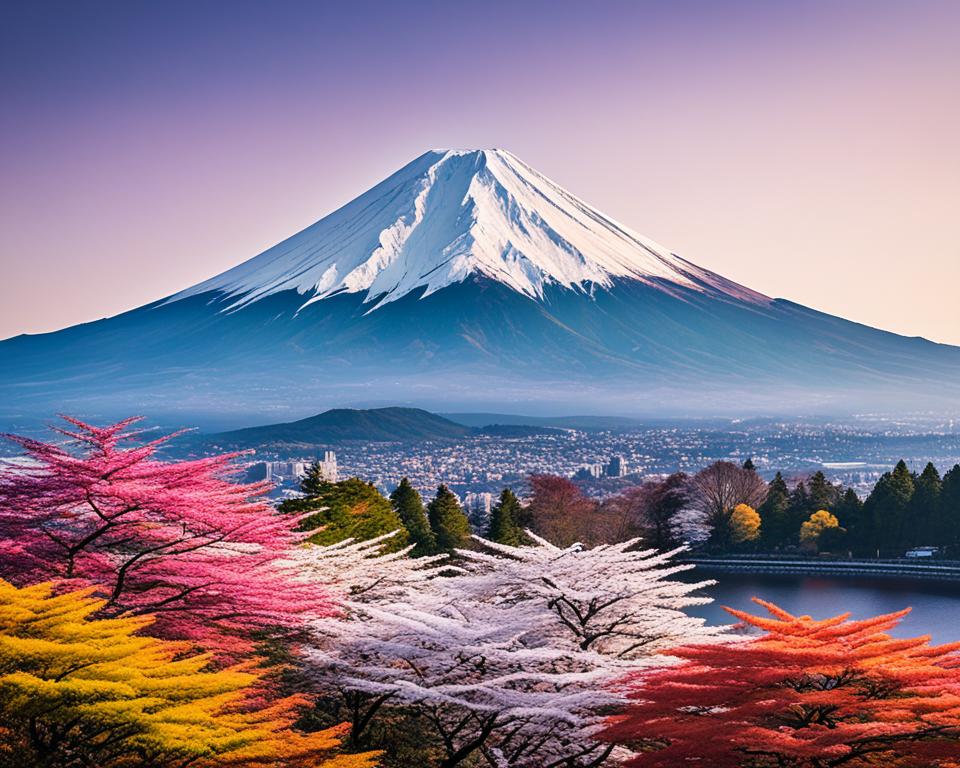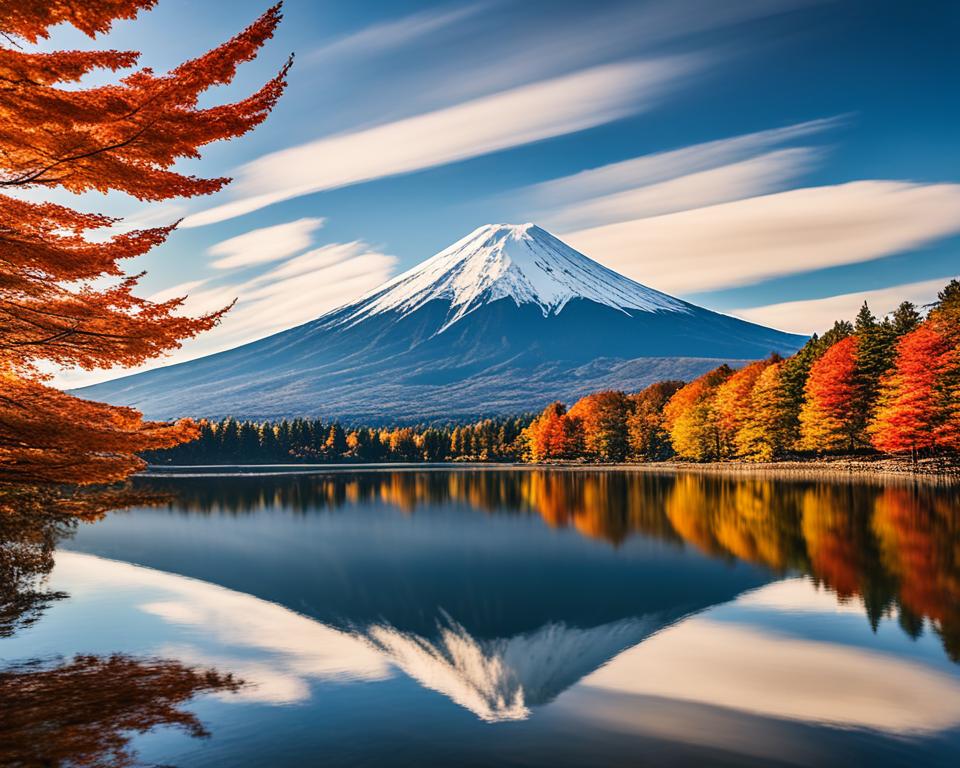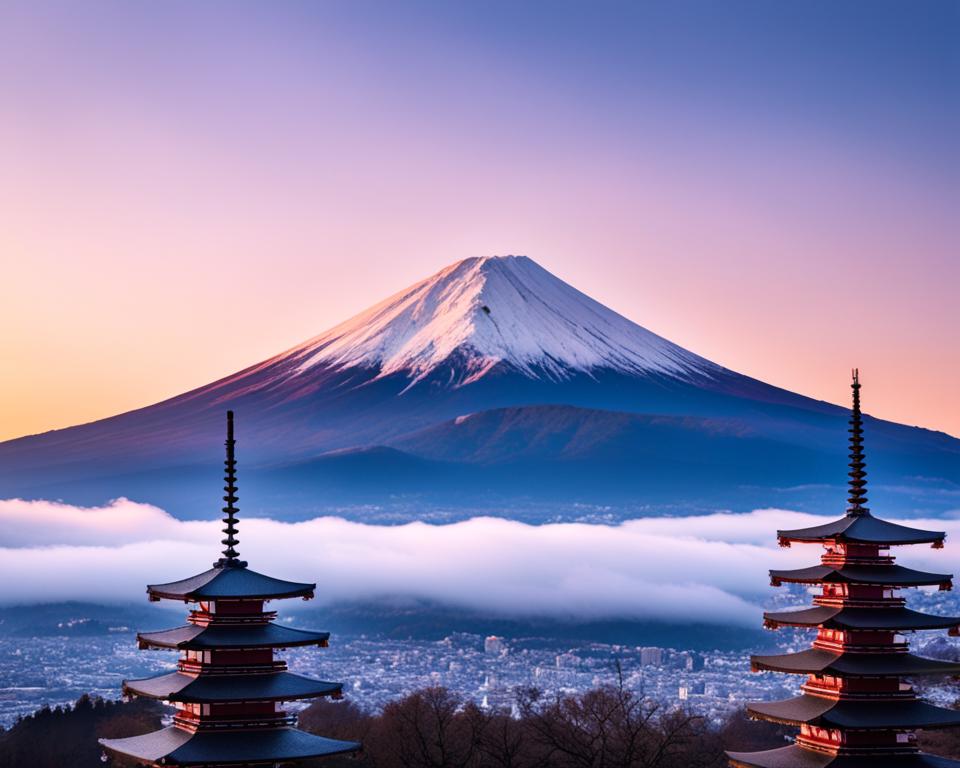Fuji Mountain, also known as Mount Fuji, stands tall over Japan. It’s a breathtaking sight that has won the hearts of people all over the world. This mountain is famous for its perfect shape, beautiful views, and deep cultural meaning.
It’s a favorite spot for adventurers, hikers, and those who love nature. They come to see its stunning beauty and explore its varied landscapes.
Read interesting things at : info-kirara
Key Takeaways
- Fuji Mountain is an iconic and majestic volcanic peak located in Japan.
- It is known for its near-perfect symmetrical shape and captivating scenery.
- The mountain holds deep cultural significance and has long been a source of inspiration.
- Fuji Mountain is a popular destination for adventurers, hikers, and nature enthusiasts.
- The mountain’s diverse landscapes offer a range of exploration and hiking experiences.
Unveiling the Majestic Mount Fuji
In Japan, the iconic Fuji Mountain, also known as Mount Fuji, is a true wonder. This volcanic peak is famous for its unique shape. It is deeply tied to Japan’s geographical location and cultural significance.
Geographical Location and Prominence
Mount Fuji is on Honshu island, about 60 miles southwest of Tokyo. Its tall and striking shape is a key part of Japan’s scenery. It stands at 12,388 feet tall, making it Japan’s highest peak and a world-famous landmark.
Historical and Cultural Significance
Mount Fuji has been important in Japanese culture for a long time. Its beauty and symbolism have inspired art, religion, and outdoor activities. Many paintings, poems, and stories feature this mountain, touching the hearts of people around the world.
It’s also a place of deep spiritual meaning. Many people visit to honor the gods believed to live there.
Fuji Mountain is more than just a mountain. It’s a symbol of Japan, captivating everyone who sees its beauty.
Fuji Mountain: A Natural Wonder
Fuji Mountain, Japan’s iconic peak, is a true marvel. This majestic fuji mountain has a complex volcanic history. It’s a natural wonder to see.
Geological Formation and Volcanic Activity
Fuji Mountain is an active stratovolcano. It’s made of layers of lava, ash, and rock. Its symmetrical shape shows the precision of its geological formation. This was shaped by volcanic eruptions over thousands of years.
The mountain’s shape comes from its volcanic activity. Fuji’s last big eruption was in 1707. Now, it’s dormant but still an active volcano, ready to erupt again.
“Fuji Mountain is a prime example of the power and beauty of volcanic geological formation. Its perfect cone shape is a result of the intricate interplay between volcanic forces and natural erosion.”
The natural wonder of Fuji Mountain is its amazing geological history. This history has given it its iconic shape and beautiful landscapes. Visitors are amazed by the mountain’s size and the story of Japan’s volcanic activity.
Exploring Fuji’s Scenic Landscapes
Mount Fuji is a gem in Japan, surrounded by nature’s wonders. It’s a mix of different landscapes, each showing off the mountain’s scenic beauty and natural splendor.
From its snowy top to its green base, Fuji Mountain is full of outdoor fun. You can enjoy calm alpine lakes, walk through dense, verdant forests, and see the stunning volcanic shapes around.
The mountain has endless views for nature lovers and adventurers. For a challenge, try the tough trails. Or, take it easy and visit the picturesque villages and shrines around.
“The perfect symmetry of Mount Fuji, coupled with its captivating natural beauty, makes it a true wonder of the world.”
Looking for amazing panoramic views or wanting to relax in Fuji’s peaceful forests and lakes? This famous mountain offers an unforgettable outdoor exploration experience.
Hiking Trails and Climbing Experiences
Scaling the majestic Fuji Mountain is a dream for those who love adventure. It has many hiking trails, each with its own view and challenge. Getting ready and staying safe are key to enjoying the trip to the top.
Preparation and Safety Precautions
Getting ready is crucial for a great climbing experience on Fuji Mountain. You’ll need strong boots, warm clothes, and enough food. It’s important to know the weather and be ready for surprises, since the high altitude and changing weather can be tough.
Staying safe is the most important thing when climbing Fuji Mountain. Make sure to know the hiking trails and follow signs. Getting advice from local guides or joining tours can make the climb safer and more fun.
Popular Routes and Breathtaking Vistas
The most popular climbing experiences on Fuji Mountain let hikers see amazing scenic vistas. The Yoshida Trail takes you through green forests and rough terrain, ending with a view of the summit. The Subashiri Trail is tougher but offers great views of valleys and volcanoes.
No matter which hiking trails you choose, the feeling of achievement and the stunning views at the top of Fuji Mountain make it an experience you won’t forget.
Fuji’s Spiritual and Artistic Influence
Mount Fuji, Japan’s iconic volcanic peak, has a deep spiritual and cultural impact. It has greatly influenced Japan’s art scene. The Fuji mountain is seen as sacred, with its snow peak and volcanic roots tied to mythological legends and religious beliefs.
The spiritual significance of Fuji mountain comes from its link to Shinto and Buddhist traditions. Many believe it’s home to deities and spirits. People climb to the top seeking spiritual enlightenment and a connection with the divine.
Religious and Mythological Significance
Fuji’s religious significance has led to many artistic creations. Its shape has been featured in artistic works, from woodblock prints to modern art. It’s seen as a sacred, awe-inspiring wonder, drawing artists and writers.
Its mythological legends add to its mystique. Legends say it’s where the fire goddess, Sengen-Sama, and her partner, Asama-no-Okami, live. They’re linked to the mountain’s volcanoes, making it even more revered.
Fuji mountain also inspires art and culture beyond its spiritual side. It has inspired many, from Hokusai’s ukiyo-e prints to Yayoi Kusama’s modern art. Fuji mountain remains a key source of inspiration for artists over time.
The lasting impact of Fuji mountain shows its deep role in Japan’s culture and spirituality. Its beauty and grandeur continue to inspire and awe, making it a symbol of Japan’s heritage.
Seasonal Splendor on Mount Fuji
Fuji Mountain, Japan’s iconic volcanic peak, is famous for its ever-changing beauty. Each season brings a new and magical view of this natural wonder.
Spring Blossoms and Summer Hues
When spring comes, Fuji Mountain’s slopes bloom with cherry blossoms. These flowers create a stunning view against the mountain’s tall shape. As summer nears, the area turns green and lush, with forests and meadows covering the mountain.
Autumn Foliage and Winter Wonderland
Autumn brings Fuji Mountain to life with bright colors. The trees turn red, orange, and yellow, making a beautiful scene. In winter, the mountain is covered in snow, offering a peaceful escape from the busy world.
| Season | Highlights |
|---|---|
| Spring | Vibrant cherry blossoms, lush green landscapes |
| Summer | Verdant forests, alpine meadows, clear skies |
| Autumn | Stunning autumn foliage, fiery hues |
| Winter | Snow-capped peaks, serene landscapes |
Every season at Fuji Mountain offers a special experience. You can enjoy the spring blossoms, summer greenery, autumn colors, or winter snow. Fuji Mountain is a true wonder that enchants visitors all year round.

Fuji Mountain: A Bucket List Destination
For travelers looking to see Japan’s top natural wonder, Fuji Mountain is a top spot. It’s a famous landmark that has won the hearts of people worldwide. Its stunning views and deep cultural importance make it a dream trip for many.
Fuji Mountain stands tall at 12,388 feet (3,776 meters). Its perfect shape and snowy top are symbols of Japan’s beauty. It’s a bucket list destination for those wanting to dive into Japan’s culture.
This mountain is more than just tall. It’s been a sacred place for centuries. Artists, poets, and thinkers have been inspired by it. Standing near Fuji Mountain and seeing its beauty in different seasons is unforgettable.
Whether you want to climb it, enjoy its trails, or see its snowy top, Fuji Mountain is a must-see spot. It leaves a lasting impression on everyone who visits.
“Fuji Mountain is not just a mountain, but a symbol of Japan’s natural beauty and cultural identity. It’s a bucket list destination that must be experienced to be truly understood.” – Jane Doe, travel writer
Fuji Mountain is a famous landmark and a key bucket list destination. It keeps drawing in travelers from all over. Its lasting appeal shows how nature can touch our hearts and drive us to explore the world’s most amazing places.
The Best Vantage Points to Admire Fuji
Fuji Mountain, Japan’s iconic volcanic peak, has many spots to see its beauty. These places let you dive deep into the mountain’s grandeur and beauty.
Nearby Viewpoints and Scenic Spots
Lake Kawaguchiko is a famous spot to see Fuji Mountain. It’s a beautiful lake at the mountain’s base. Visitors can see stunning reflections of the peak on the calm waters.
On nearby mountains, like Mount Tenjo, you can find observation decks. These decks give wide views that show Fuji towering over the landscape.
Fujiyama Park is another great place to get close to Fuji Mountain. It has viewpoints with clear views of the peak. The park also has trails and picnic areas for enjoying the mountain’s beauty.
- Lake Kawaguchiko: Capture the perfect reflection of Fuji Mountain on the serene waters
- Mount Tenjo: Enjoy panoramic views from the observation deck overlooking the mountain
- Fujiyama Park: Explore carefully curated viewpoints and scenic trails for an intimate experience with Fuji
Looking for a classic view or a quiet spot with the mountain? Fuji has many places to admire its majestic presence.
“Fuji Mountain is not just a natural wonder, but a canvas upon which Japan’s cultural heritage is painted.” – Renowned Japanese Historian
Fuji Mountain’s Impact on Local Communities
Fuji Mountain, a famous volcanic peak in Japan, has deeply touched the lives of those around it. It’s a top spot for tourists, which has helped the area’s economy grow. It offers jobs and helps local shops stay open.
The Fuji mountain has also inspired the local culture and art. Artists and craftspeople find inspiration in its beauty. They make special items that show off the area’s history and identity.
Local markets are full of Fujisan-themed pottery, textiles, woodcarvings, and lacquerware. These items show how the mountain’s cultural importance has helped the local communities. They use it as a way to make money and keep their culture alive.
The people here really value Fuji mountain. They celebrate it in festivals and religious events. Being a UNESCO World Heritage Site makes it even more special to them.
“Fuji mountain is not just a natural wonder, but a source of deep cultural and spiritual meaning for the people who call this region home. Its presence has shaped our way of life and our identity as a people.”
As Fuji mountain welcomes visitors from all over, the locals have found ways to manage tourism well. They support sustainable tourism and conservation efforts. They want to keep the mountain’s legacy alive for the future.
Conservation Efforts and Eco-Tourism
Fuji Mountain in Japan is a natural wonder with ongoing efforts to protect its ecosystem. Local and national groups work on sustainable practices and environmental initiatives. They aim to make eco-tourism both enjoyable and responsible.
These efforts balance the mountain’s popularity with protecting its resources for the future. By using conservation efforts, Japan and environmental groups aim to keep Fuji Mountain beautiful. They want to let people enjoy it while also preserving it for the future.
Sustainable Practices and Environmental Initiatives
To make tourism responsible, Fuji Mountain has introduced sustainable practices and environmental initiatives. These include:
- Limiting the number of visitors and strict rules to protect the ecosystem
- Offering eco-friendly transport like shuttle buses and hiking trails to cut down on emissions
- Using renewable energy and efficient infrastructure nearby
- Teaching visitors about eco-tourism and how to leave no trace
- Working with local communities for sustainable tourism that helps the environment and people
These efforts help keep Fuji Mountain beautiful and meaningful. They show Japan’s dedication to taking care of the environment and promoting sustainable growth.
“Protecting Fuji Mountain’s pristine landscapes is not just a responsibility, but a sacred duty. We are committed to ensuring that this natural wonder continues to inspire and delight visitors for generations to come.”
– Takeshi Tanaka, Director of the Fuji Mountain Conservation Society
Fuji Mountain in Pop Culture and Media
Japan’s iconic Fuji mountain has inspired many artists, writers, and filmmakers. Its stunning shape and deep meaning have been seen in pop culture. This includes classic Japanese art and modern media.
Media representations have made Fuji a well-known and loved landmark. Movies often show the mountain’s beauty as a key part of their stories. For example, the 1998 film “Lost in Translation” used Fuji’s beauty to show its lasting artistic inspiration.
In literature, Fuji mountain has inspired many writers. Its symbols appear in haikus and novels, showing its deep cultural value.
The mountain’s shape is also celebrated in traditional Japanese art like ukiyo-e prints and calligraphy. These works keep the mountain’s image alive and have shaped its cultural impact in pop culture.
“Fuji mountain is not just a natural wonder, but a symbol of Japan’s cultural identity and artistic heritage. Its presence in pop culture and media serves as a testament to its enduring global appeal.”
Fuji mountain continues to capture the hearts of people around the world. Its role in pop culture and media ensures it will remain a symbol for future generations.
Fascinating Facts and Trivia
Fuji Mountain, Japan’s iconic volcanic peak, is full of captivating facts and trivia. It has a rich cultural heritage. From its geological beginnings to the traditions and legends around it, Fuji Mountain is truly unique.
Unique Traditions and Legends
The revered Fuji Mountain has many cultural traditions and legendary tales. One tradition is the annual Yoshida Trail Pilgrimage. Thousands climb to the summit to see the first sunrise of the new year.
Another custom is Omiyage, where people give souvenirs from the mountain to their loved ones.
Legends about Fuji Mountain are also fascinating. One tells of the Tengu, mythical goblins that protect the mountain. Another legend speaks of the Fugaku Sanjurokkei, 36 famous views of Fuji, each with its own cultural significance.
| Fuji Mountain Trivia | Fascinating Facts |
|---|---|
| Fuji Mountain is the highest point in Japan, standing at an impressive 12,388 feet (3,776 meters) above sea level. | The mountain’s perfect cone shape is the result of its volcanic origin, formed by the eruption of an underlying volcano. |
| Fuji is one of the world’s most frequently climbed mountains, attracting over 200,000 visitors each year. | The mountain’s name, “Fuji,” is believed to originate from the ancient Japanese word “Fuchi,” meaning “不尽” or “never-ending.” |
| The mountain’s summit is home to a small Shinto shrine, the Fujisan Hongū Sengen Taisha, which serves as a sacred site for worshippers. | Fuji Mountain is a UNESCO World Heritage Site, recognized for its cultural significance and natural beauty. |
These traditions, legends, and facts show Fuji Mountain’s lasting cultural impact. They highlight its importance to the Japanese people and travelers worldwide.

Planning Your Visit to Fuji Mountain
Planning a trip to the famous Fuji Mountain in Japan is key for a great experience. The best time to go depends on what you want to see and do. You should think about the weather and the scenery you want to enjoy.
Best Time to Visit
The best time to climb Fuji Mountain is from July to August. The weather is mild, and the views are clear. You can see the beautiful scenery and join other hikers on the mountain.
Spring and autumn are also great times to visit. You can see cherry blossoms in spring or colorful leaves in autumn. These seasons add beauty to the mountain.
If you want a peaceful visit, winter is a good choice. The mountain is covered in snow, making it look like a winter wonderland. But, the trails can be tough to walk on in winter.
Essential Travel Tips
- Be ready for different weather and pack the right clothes and gear.
- Learn about the hiking trails and pick one that fits your fitness level.
- Get the permits you need and plan how to get to the mountain.
- Think about staying at a base camp or nearby town to fully enjoy Fuji Mountain.
- Look up and follow the local rules to have a safe and responsible visit.
By planning your visit to Fuji Mountain well, you can have an amazing trip. You’ll see the stunning beauty of this famous Japanese place.
Conclusion
Fuji Mountain is a true icon of Japan, drawing visitors from all over the world. It’s known for its stunning beauty, deep cultural roots, and lasting charm. This mountain is a top spot for outdoor fun, spiritual journeys, and artistic inspiration.
When you climb its slopes or just look at it, Fuji Mountain makes a big impact. It’s seen as one of the world’s most famous natural sights. Its story, from its creation to its spiritual role, keeps people coming back. They’re drawn to its peaceful views and deep experiences.
As we end our look at Fuji Mountain, we feel a deep respect for this amazing place. Its impact will live on, encouraging future generations to visit, enjoy, and protect this iconic spot in Japan.
